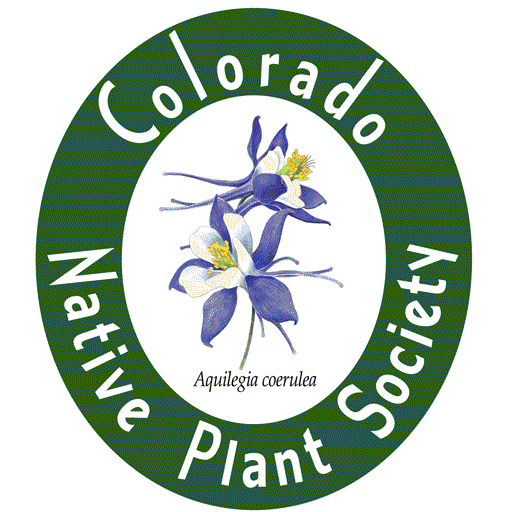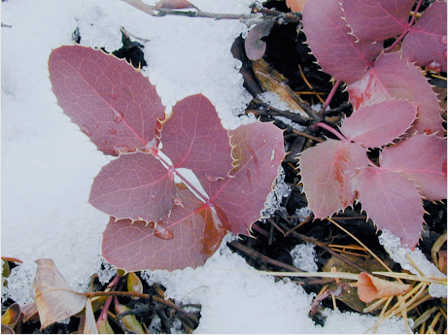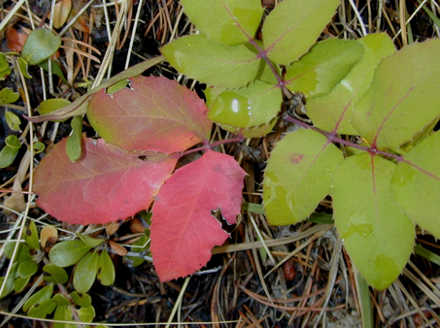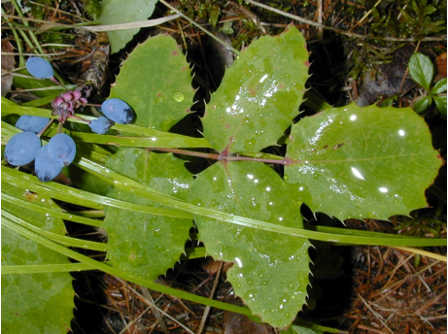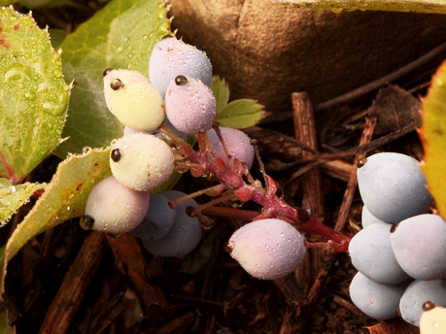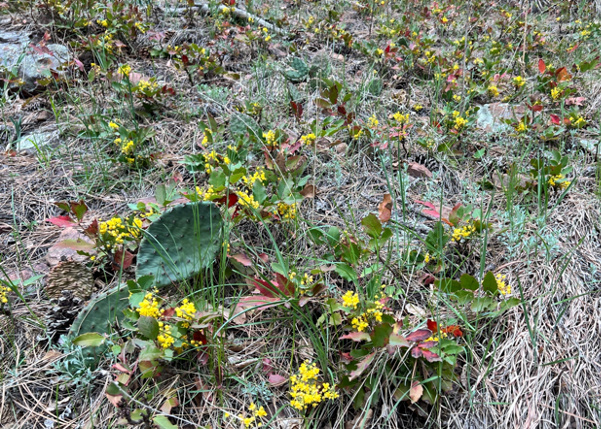When talking about native plants for landscaping or restoration we normally think of colorful flowers that can grow well out in the sun in dry landscapes. But ecologists learned long ago that diversity and ecological function in most places is tied to a diversity of plant forms and landscape elements, ideally with multiple layers of vegetation, from the soil layer to high in tree canopies. Even here in the Rockies despite dry air abundant sun and drying winds we do still have moist pockets in most landscapes, such as gullies, canyons, north facing mountain slopes, water seepages, streams and rivers as well as high elevation forests. Plants even in small moist spots can be important elements of our natural diversity across landscapes.
Right now at low elevations around the Front Range Creeping barberry is in flower; though it often still has some reddish leaves when it flowers early. One peculiar thing is the flowers are in parts of 3 (more typical of a monocot) even though this is a dicot, and the sepals are also yellow.
One plant I think deserves particular mention is what some might consider a fairly humble plant: creeping barberry or Oregon grape, (Berberis repens). It is fairly common in shady or moist places and is easy to overlook with all of the larger plants around it with their showy flowers or dense leaves. But I still consider it unique. This is because it is one of the very few broad-leaved evergreen plants in our area. When you think of broadleaf evergreen plants its easy to conjure up images of steamy jungles, or moist fog-drenched coastal forests. Not dry forests or shrub-steppe like here in the Rockies. This barberry is one of the few the exceptions. Scientists and other naturalists often can learn a lot from studying exceptions like this.
So why is this plant successful as an evergreen broad leaf plant? First of all consider that while the barberry may be somewhat unique here, in is fact it is part of a very successful plant family and genus. Over 500 species belong to the barberry family. Mostly in the subtropics or moist temperate zone such as in southern South America, where in places I have seen 20 or more species at a time, and also in similar habitats in eastern Asia. Most are evergreen, but several are deciduous. Some of the deciduous species are so successful in colonizing moist temperate forests they can become invasive such as the common ornamental Berberis japonica and Berberis vulgaris from Europe. So, creeping barberry is related to a very diverse and successful group of plants.
Berberis in winter. It usually keeps this color until it breaks dormancy in the spring.
In the spring as plants break winter dormancy, some leaves turn bright red before they start producing green chlorophyll pigments. You can see this in the fall as well as they start to harden off and go into winter dormancy. Note here that bearberry or kinnikinnick (Arctostaphylos uva-ursi) is also a great plant for covering shady spots in your yard.
Creeping barberry belongs to a special group of barberries that botanists over my lifetime have had the hardest time figuring out what to name. Mahonia is often the name given for botanists that consider them a unique group. They are distinguished from the other barberries by having no spines on the stem, and having broad spiny leaves usually divided into leaflets. Colorado actually has 6 species of Berberis/Mahonia or barberry. Two in the Mahonia group including the taller B. fremontii on pinon-juniper woodlands on the west slope and Berberis repens. We have the exotic European deciduous species (B. vulgaris) in a few locations, and we even have one native deciduous species with simple leaves, B. fendleri which occurs in western and southern portions of the state in both riparian and pinon-juniper habitats. So it is remarkable how many species we have given our dry tough habitats for shrubs like these. One of the unique characters that helps creeping barberry survive in these places is its tough waxy leaves that are good at retaining moisture and surviving the cold. These leaves turn red in fall to help protect against sunlight when it is dormant. Its low stature and ability to tolerate shade also helps these plants conserve moisture. It also has rhizomes or underground stems which allow it spread all across shady habitats. This is a good reproductive strategy for plants growing under forests where it is often difficult to establish new seedlings.
I know some wildflower enthusiasts here do not like the name Oregon grape. What is that about? It is not a grape and it seems to grow fine here. I have had the opportunity to study forests in Oregon and for me it actually seems like a good name. In Oregon it is ABUNDANT. In second growth Douglas-fir forests Berberis aquifolium can carpet whole mountainsides where there is good shady habitat. This is the species with shiny leaves that you often see used as an ornamental in shady spots and irrigated landscapes. It can also naturalize here in moist places, like alongside streams. The creeping Oregon grape is also abundant in Oregon. From rocky dry habitats on the wet western slope of the Cascades, to a wide range of habitats east of the Cascade crest. The grape in the name refers to the bright bloom covered bluish berries that resemble tiny grapes and really stand out in otherwise leafy vegetation on the forest floor.
The mature berries are hard to miss. Too bad they are not particularly tasty. But they are edible, but usually quite tart and seedy. Both the berries and the yellowish roots have been used in traditional medicine.
For gardens this low growing or “subshrub” can provide a lot of interest with bright colors of leaves in fall and spring and muted colors in winter, very early yellow flowers (it has been flowering for weeks this year, despite all these snow storms), and its bright colored berries. Berries are edible, but not choice and fairly seedy. These plants also provide some unique structures and habitat for a variety of insects. It is considered an important source of pollen and nectar for native ground nesting bees, especially valuable early in the season.
In the summer or early fall berries form. Here they are just starting to ripen.
Here you can see the creeping barberry under a ponderosa pine woodland in an open space near Boulder which provides a huge patch of flowers to attract pollinators this week (April 29th).
I think it is also just interesting to have a more unique native plant in those shady spots where we often ask what natives can we grow here?. The greater the diversity we have structurally or in terms of species and lifeforms the more ecological value we are likely to create in these habitats. So the next time you are walking through a shady forest spot or along a gulley or seepage take note of these interesting yet often overlooked plants. Or consider them for adding some native diversity to shady spots in your yard.
All photos from the author
Paul Alaback
Professor Emeritus of Ecology
University of Montana
palaback@gmail.com
